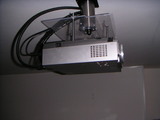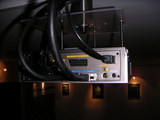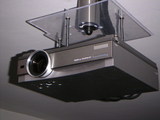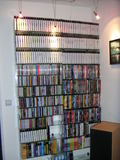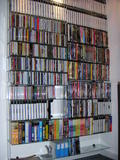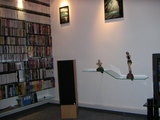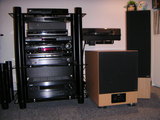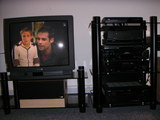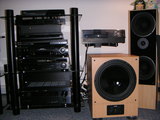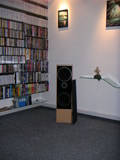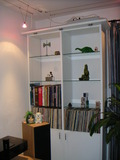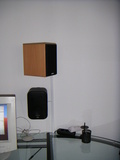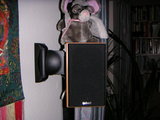Mk 3. The big-screen period.
General
Already since Mk 1 in 1994, I had dreamed of a projector. However, the high prices, moderate quality, and to a certain extent the very bulky devices made it stay a dream. Ten year later, in 2004, the prices had gone down and the quality up, and I saw in the Panasonic PT-AE 500 the device I had been waiting for in 10 years. (Many other persons obviously felt similarly, so I had to wait almost two months for delivery...). The problem with shortage of inputs was solved by the new Yamaha Receiver (RX-V 1400). Since that device supports 7.1 channels, two more loudspeakers (Nubert NuWave RS-5) "were necessary". I also bought a relatively simple pull-down screen (16:9 format, 2.34 meters wide, gain 1.0) from Mediastar.
Getting this stuff to work, and work well, turned out not exactly to be "unpacking, connecting the wires, go". To get the picture right, the screen and the projector has to be correctly aligned within centimeters, preferably millimeters. A roof lamp had to be removed. At that time, a sensible, and reasonably priced projector mount did not seem to be available. Therefore, the projector mount is of my own construction, although I acknowledge the influence of this thread in AVS-Forum. It consists of a furniture foot (!) in the shape of a solid iron tube, attached to a plexi glass piece by only one (but large) bolt (thus it can be rotated). The projector is attached to the plexi glass sheet using four iron rods with M4 thread. Using wing nuts and springs, position and angel of the projector can be adjusted. The mount thus provides four degrees of freedom. Total cost: around 15 Euros.
To make screen, TV, and other devices fit, TV table and Hifi Tower had to be lowered (thanx to Günter for cutting the steel tubes for me).
The now over 11 years old TV has started to show signs of its age (had had problems with vertical deflection, see above). The tuner broke, so I replaced it early 2004. There was also a problem with 16:9-mode, that I managed to fix. (Thanx again to Günter, this time for lending me the oscilloscope.)
The roller-curtain mechanism for the screen did not stop exactly where I wanted it to. So I threw it out, and replaced it with an electric tube motor from a local hardware store. For remote control, it was connected with an IntertechnoCMR - 500 switch, see the section on home automation. Finally, recently the lower bar was made heavy by a solid iron bar, to keep the screen hang as flat as possible.
Video signals, in CVBS, S-Video, or YUV format are feed into the Yamaha receiver. In the first two cases, the signal is up-converted to YUV by the Yamaha, and feed through three RG-59 cables (20 meters) to the projector. The drawback with this method is that the format information is lost (no pin-8 on SCART, no WSS on line 23), thus I have to adjust the aspect ratio of the projector manually.
Both the dBox, and the DVD-player deliver YUV signals to the projector, and RGB (through the Vivanco SCART-Switch) to the TV. Unfortunately, for both of them, they cannot deliver YUV and RGB at the same time (the number of Video DA-Converters is simply not enough). Both of them are "reconfigured" between RGB mode and YUV (+ CVBS)-mode. For the dBox, I have my own shortcut on a certain key doing this with just one key press (with the standard software this is not possible). For the DVD player, I have to go into the setup menus, enter the video section, and make the change there. I have two Pronto macros for this. As with all elaborate macros of this kind, the reliability is not 100%.
Many, or rather the most, of my favorite movies are not 16:9 aspect ratio (or, approximately the same, 1.85:1), but the wider 2.35:1 format ("Cinemascope"). Thus, it leaves black "letter-box" bars on the 16:9 screen. To "frame" the picture better, I made masking boards of solid wood, covered with black velvet-type adhesive film ("dcfix"). Thus, the black bars are not medium-gray, but really black, which adds quite a lot to the cinematic experience. (Using subtitles, this may have a drawback, in particular if the subtitles falls partly on, partly outside of the board. This disadvantage can to some extent be circumvented by the DVD-Player, that is able to adjust the vertical position of the subtitles.)
I love the wide Cinemascope movies. Unfortunately, it is pretty hard to reproduce at home (which is probably a part of the explanation of why the movie industry invented it in the first place :-) — either (for the case of a 4:3 screen), half of the screen is just black (so-called letter-boxing), or, half of the content is brutally chopped ("Pan and Scan", a practice just too common both in commercial and public TV. (Really, it is all depending on whether you consider the TV to be there to show the movie, or the movie to be there to fill up the TV.)
To do some tuning on the projector in the sense of, e.g., cine4home, the projector was equipped with a 52 mm red filter KR3.
Unfortunately, I was somewhat unhappy with the usage concept of the Panasonic projector, see the section on remote control.
Details on Mk3.
- Projector Panasonic PT-AE500 [1280 x 720 resolution] (2004-03-05)
- Receiver Yamaha RX-V 1400 (2004-01-20)
- Loudspeakers:
- Front Left/Right: NuBox 460 (2000-07-07)
- Center: NuBox CS-3 (2000-07-07)
- Surround Left/Right: NuLine RS-3 (using Vogel's VLB 100 wall brackets)
- Left/Right Back Surround: NuWave RS-5 Antrait (2004-01-23)
- Subwoofer: NuBox AW-850
- Screen Mediastar 16:9, 2.34 meters wide
- Turntable Thorens TD150/II (purchased 1972), equipped with SME Model 3009 Series II Improved Arm and ADC XLM MKII stylus.
- Timer: Pioneer DT-555 (only used as clock)
- TV: Philips Matchline 28ML8805
- Laserdisk Player: Sony MDP 650D
- DVD Video/Audio Player: Panasonic S75. Regional Code free (using a special remote control).
- S-VHS ET Recorder Philips VR-1100
- Nokia dBox II running Tuxbox
- "Telefunken" PALplus-decoder (manufactured by Nokia)
- Stax SR-X Mark 3 electrostatic earphones, with SRD-6 adapter. Purchased in 1982.
- Remote Control: Philips Pronto RU 890 (purchase 2000-09-05)
- TV-Live Light 13W
- Vivanco Control 5. Modified.
Photos from Mk 3
Continue to Mk 4. Real loudspeakers.



